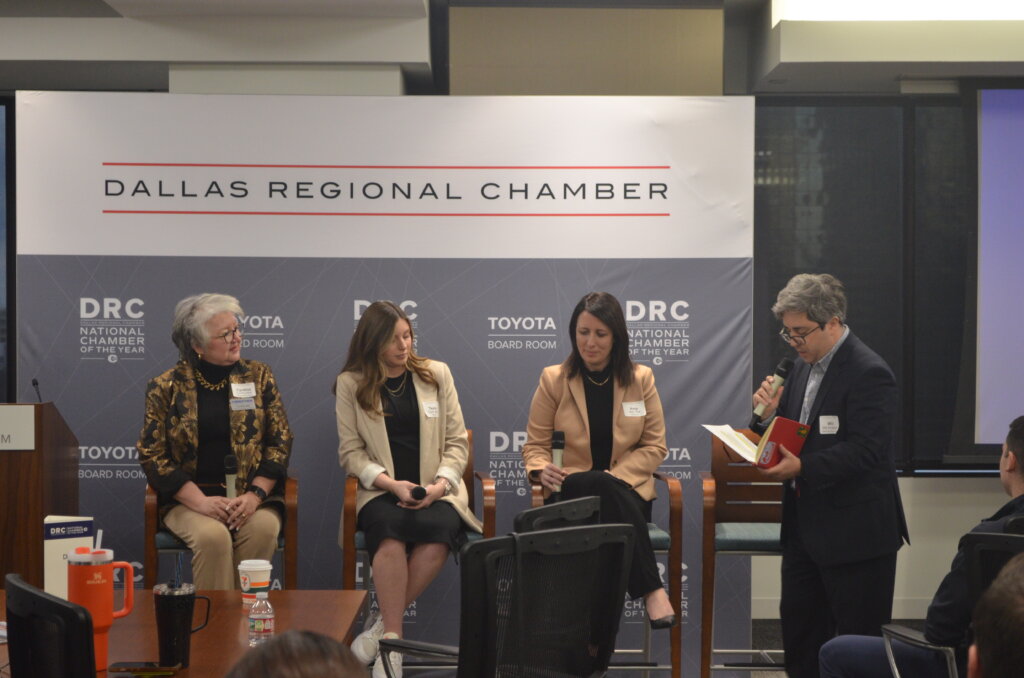By Catie George, Manager, Communications & Storytelling
The Dallas Regional Chamber (DRC) hosted its first Talent Talk of the year, presented by BGSF and Holmes Murphy, on Wednesday, March 20. The event was focused on the Dallas Business Journal’s Best Places to Work designation and featured companies that had received the honor. If you missed it, take a look at the key takeaways below.
- Finding talent is a challenge for everybody.
With over 770,000 current job openings in Texas, filling those roles is a major challenge.
“It’s a problem that stems from growth and innovation, while some cities in the regions of this country are dealing with problems from stagnation of the population,” said Dallas Business Journal’s Editor-in-Chief Will Anderson. “But it’s still a challenge, and one that rightfully demands a lot of time investment.”
- Know your culture.
“[Culture is] critical. It’s why you join a company, but it’s also why you stay at a company,” said Taylor Bretl, Manager of Talent Acquisition at Slalom.
Culture as a means of recruitment is also a great way to stand out in a competitive market.
“Our best representatives of our culture are our people,” said Cynthia Ball, Director of People Operations at The Crowther Group. “We have to be competitive, especially in construction. We’re all looking for the same type of person. We have to be very direct and full of intent in sharing and living what our culture is.”

- Embrace change and challenges.
From a pandemic to an artificial intelligence boom, all industries have experienced major challenges over the past five years. It’s important to remember that adjustments are continually necessary.
“Personally, professionally, from a corporation standpoint, everything’s a work in progress,” said Amy Tice, Chief People Officer at Ryan, LLC. “Just because you put a lot of blood, sweat, and tears into a program, and it was exactly what you needed then, that does not mean it wasn’t successful when you need to evolve it 18 months later, or you need to evolve how you have practices or what you’re doing.”
- Communicate clearly and be honest.
While working to fill roles, it is important that companies are clear on their expectations and properly convey that to applicants.
“I think transparency shows that if you’re setting them up for success, you want the best for them,” said Bretl. “The transparency piece is so vital. But I think, too, that a lot of it comes with building a supportive workplace and looking at what that looks like when it comes to attracting talent.”

- The DRC can help with your talent needs.
“We have expanded our focus on talent. For the past 15 years, we’ve focused on education and workforce and talent attraction, really working alongside our educational institutions to make sure that you have the talent you need coming from our education systems,” said Elizabeth Caudill McClain, Senior Vice President of Talent Strategies at the DRC. “But what we heard from you all in the strategic planning process was, yes, and we need more. We need more support in the entire talent life cycle, not just from education systems but also for attracting, retaining, and developing talent.”
To get help from the DRC for your talent and workforce needs, visit our resources page.
Thank you to our presenting sponsors, BGSF and Holmes Murphy. Thank you to our corporate sponsor, KEIRUS by KJE. Thank you to our featured employers, OCC and Medical City Healthcare.
To learn more about what the DRC is doing to retain and attract talent to the Dallas Region, visit our website.